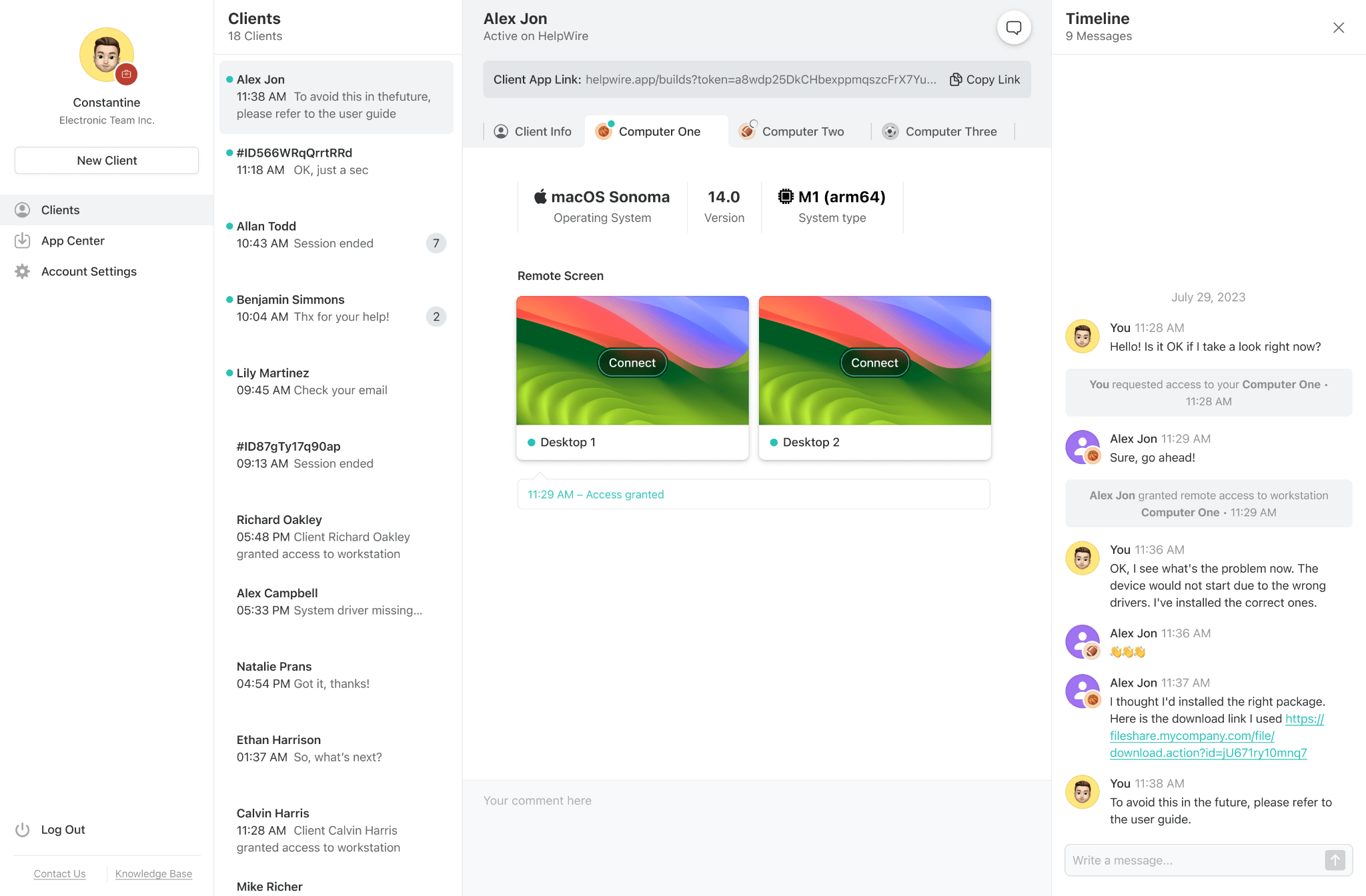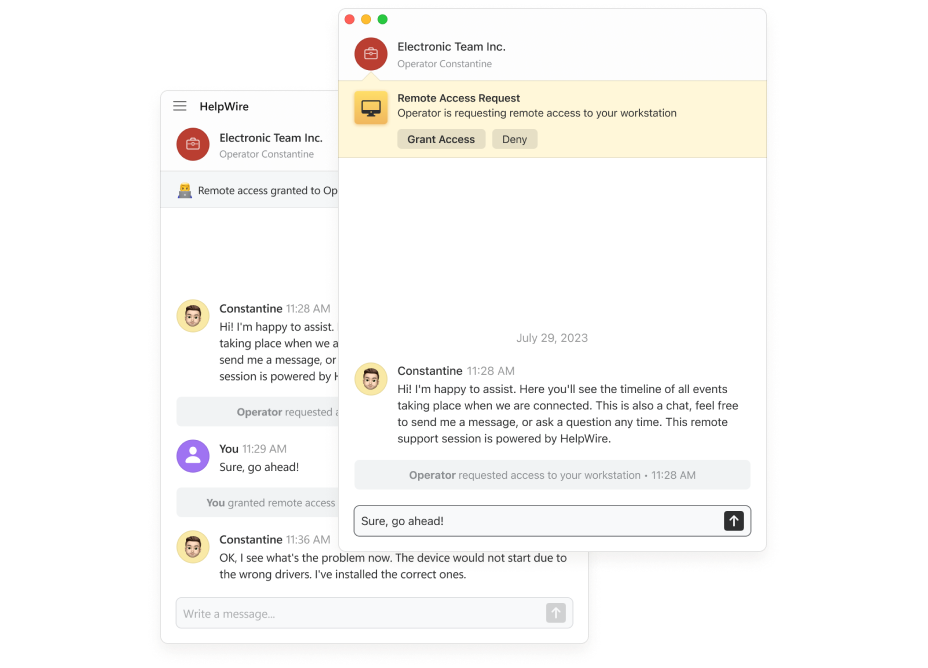Remote support software has become a cornerstone in diverse business contexts. Its role is crucial not only in enhancing the efficiency of technical support and help desk teams in both small and larger businesses but also in providing vital assistance for remote family members’ computer troubles. The challenge lies in finding a tool that delivers the necessary capabilities without imposing financial strain. The ideal solution merges user-friendliness with a comprehensive feature set, allowing technical support teams to address customer issues effectively and efficiently.

Key Considerations for Small and Medium Businesses (SMBs) in Remote Support Tool Selection
For SMBs, choosing the right remote support software necessitates careful consideration of several factors. Opt for a software solution that offers a straightforward, easy-to-navigate interface and features designed for user convenience.
Features: The tool should encompass all functionalities essential for comprehensive remote support.
Affordability: It’s crucial to find a solution that aligns with the company’s budget.
Security and Privacy: The software must guarantee robust security and privacy measures, particularly critical for handling regulated data.
Ease of Use: The tool should be straightforward, minimizing the need for specialized skills or extensive training.
Scalability: Ensure the software can accommodate the growing needs of the business.
Compatibility: The tool should seamlessly integrate with the existing IT infrastructure and the various devices used by employees and clients.
Introducing HelpWire: Simple and Free Remote Support Solution

HelpWire is a cutting-edge, complimentary remote desktop service that empowers IT environments with the ability to provide prompt, secure remote connections.
Efficient and Accessible: It enables customer service technicians to access client machines instantly, resolving issues quickly and negating the need for expensive, time-consuming travel to remote sites.
User-Friendly Interface: HelpWire’s intuitive design facilitates quick problem-solving, enhancing overall user experience.
Cost-Effective Support: As a free service, HelpWire allows businesses to maximize their IT budgets while still delivering exceptional customer service, thus becoming a strategic asset in optimizing IT support capabilities.
Exploring the Comprehensive Features of HelpWire
HelpWire provides users with an extensive feature set specifically designed for small businesses, ensuring all the tools for effective remote IT support are readily accessible. This includes:
Remote Control Capabilities
HelpWire equips technical and help desk teams with vital remote control tools for top-notch remote support:
Quick Start: Launch remote support sessions rapidly using a unique client application link, streamlining the process.
Cross-Platform Support: Address issues on various operating systems, including Windows and macOS, ensuring comprehensive coverage.
Performance Optimization: Choose your preferred settings for remote screen display or data transfer speeds, or let HelpWire auto-select the most efficient options.
Multiple Session Access: Engage with several workstations of a single client at the same time for enhanced productivity.
Multi-Screen Functionality: Easily toggle between different remote screens or view more than one screen simultaneously, adding to the flexibility of the tool.
Efficient File Transfer: Simplify the process of file sharing with a straightforward copy-paste method within the HelpWire interface for quick transfers.
Client Management Features
HelpWire’s operator account comes packed with features to streamline client management and bolster customer support:
Device Insights: Automatically gather and provide essential information about client workstations to the support technician.
Client Database: Create and maintain a database with client contact information, device specifics, and notes from support sessions.
Workstation Grouping: Organize a client’s various workstations under a single profile for easier access and management.
Enhanced Client Profiles: Add detailed notes to client profiles to streamline support sessions and foster better client relationships.
Built-in Support Chat
Enhance customer support with real-time dialogue between technicians and clients.

Integrated Support Chat: Facilitate real-time communication between technicians and clients for improved support.
Concurrent Chat Sessions: Manage multiple chat conversations simultaneously, reducing wait times and improving client satisfaction.
Chat History Access: Review past interactions to provide more effective, informed support.
Robust Security Measures
HelpWire prioritizes security while maintaining user-friendliness:
No Firewall Adjustments Needed: Access client workstations securely without the need to configure firewall settings.
End-to-End Encryption: Utilize AES-256 encryption for secure data transmission, backed by WSS and HTTPS protocols.
Two-Factor Authentication: Enhance the security of technician accounts to prevent unauthorized access.
Reliable Cloud Infrastructure: Rely on the robust Amazon Web Services (AWS) infrastructure for secure cloud-based operations.
Client Permissions: Ensure client consent before initiating new remote sessions, adding an extra layer of security and trust.
HelpWire: Versatile and Essential for Various Business Sectors
Beyond small businesses, HelpWire is adaptable to a wide array of industries and use cases, including:
- IT Support Teams: For reliable on-demand remote customer support and performing tasks like software installation and system updates remotely.
- Help Desk Teams: To boost help desk team performance and productivity with reliable remote connectivity.
- Educational Organizations: Ensuring all IT equipment is accessible
HelpWire: A Game-Changer in Remote Support for Businesses of All Sizes
In conclusion, HelpWire stands out as an invaluable asset for businesses of various sizes and industries. Its user-friendly interface, combined with a robust set of features, guarantees that technical support and help desk teams can deliver efficient and effective assistance. This enhances customer satisfaction and boosts overall productivity.
The software’s cost-effectiveness and comprehensive security measures solidify its position as a strategic tool for businesses aiming to optimize their IT support capabilities without overstretching their budget.
With HelpWire, companies gain a dependable partner in managing the complexities of remote support. This paves the way for streamlined operations and superior customer service, making it an ideal solution for small businesses and beyond.


















